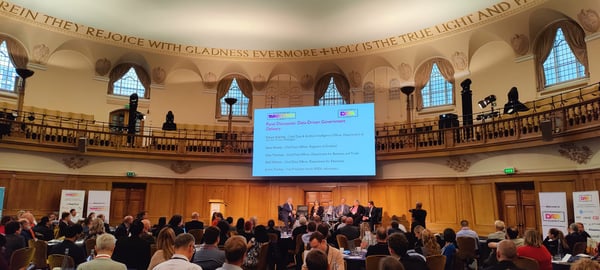Five Fundamentals for the UK to be the World’s Leading Digital Government
The Government speaks frequently about its ambition to become ‘the world’s leading digital government’ and in terms of government expenditure, it’s hard to imagine a better investment.
Digital technology is the connective tissue of modern society and should be considered a public utility. Never has that been truer than during the past two years when so many of us relied on digital technology to meet our most basic needs.
The Government has recognised the potential of technology to connect citizens, government organisations and cities and it has provided a framework for government organisations to address legacy technology debt.
But technology is rarely the greatest source of complexity when it comes to major change or transformation programmes. Government organisations operate in a highly complex environment where services need to be delivered alongside regulatory restrictions, compliance, security, resource limitations and evolving citizen needs.
If the UK Public Sector is going to be poised as ‘the world’s leading digital government’ it must invest in the technology that will help it adapt to an uncertain future.
Government organisations must have a combination of the right technology, the right processes, and the right people in place to realise its ambition. While every organisation is unique, the following five steps are fundamental for the success of any digital transformation programme.
Begin with an outcomes-based approach
Unfortunately, technology changes are often triggered by a need to replace ageing tech or in response to new regulatory requirements. This reactive approach to replacing tech debt can backfire if the solution is to patch current systems or to replicate current processes with newer tech.
When faced with the opportunity to replace and upgrade technology, organisations should forget for a moment how things are currently being done and consider different outcomes that prioritise efficiency and collaboration.
This often involves bringing in someone from outside the organisation to provide perspective of how things could be achieved differently and to evaluate current processes.
The best approach, and the one pursued by the Government, is to put citizens at the heart of all design decisions. By looking at the end objective and the impact to citizens, organisations can evaluate improved or new processes that best meet the needs of the end users while working within organisational requirements.
This may result in a new structure and part of the outcomes-based approach must include being open to the possibility of structural change.
Exploit existing technology to the fullest
If you ask IT Managers whether they would consider their organisation an early or late adopter of new technologies, many will say they’re late adopters. Yet, recent research from Global Web Index shows that 41% of IT Managers are already using automation tools, while 31% are leveraging artificial intelligence and edge computing. These are emerging technologies, often on the cutting edge.
So, where’s the disconnect? In some cases, government organisations are indeed late to adopt new technologies but often, they have access to capabilities that they’re not exploiting to the fullest.
This could include not integrating data sets between departments to share key insights or retaining manual processes that could be done more quickly and efficiently through automation.
Create opportunities to attract and retain talent
One of the biggest challenges in the public sector, in fact to nearly all organisations today, is attracting and retaining talent. This can be particularly challenging in the public sector where competition for tech talent from the private sector is fierce.
The public sector can’t compete on all fronts but, for many people, the sector is attractive because it gives them the chance to make a positive difference to the lives of others.
Government organisations need to provide those opportunities for their employees to make a difference by freeing up their time to do high value work. Technology is the key to providing more rewarding work. It can grant employees access to data that can help them make more informed decisions and it can remove the administration burden of completing manual processes.
By investing in tech, you’re investing in people and that must be included in any cost-benefits analysis.
Evaluate value rather than cost
It almost goes without saying but the public sector faces a constant demand to demonstrate value over public spending. However, an over-emphasis on costs can come at the expense of innovation, but it doesn’t have to.
The cost equation of adopting new technologies and processes should focus on value – both the short-term and long-terms benefits.
That includes the aspect of attracting and retaining talent as I already mentioned. It should also factor in efficiencies gained by automating processes and by removing duplicate processes across departments.
Ultimately, if the UK Public Sector is going to be poised as ‘the world’s leading digital government’ it must invest in the technology that will help it adapt to an uncertain future. That means factoring in the potential benefits of emerging technologies.
Connect data through the cloud
Cloud is undeniably the most transformative technology for any organisation today. In the public sector, cloud technology has generally been readily adopted for front-end, user services. This reflects citizens expectations that their public services should be as agile and user-friendly as their consumer services.
But cloud technology has not been as readily adopted for many back-office functions. This siloed approach to information has many consequences. It makes it impossible for senior leaders to connect the dots between government organisations, it hinders the ability for civil servants to help their users because they don’t have all the data they need to make informed decisions. For citizens, it results in frustration when they have to share the same information with multiple government organisations.
It’s an exciting and critical time for the UK public sector. The Government has made a bold commitment, financially and publicly, to ensure its technology is fit for the future.
The levelling up agenda is opening opportunities across the country for new collaboration and emerging talent. Ways of working are shifting to enable greater digital connectivity. By focusing on technology, talent and value, the UK public sector can ensure it’s offering the best value to its citizens – it can also become a global leader in the process.
Photo credit: Shutterstock.







